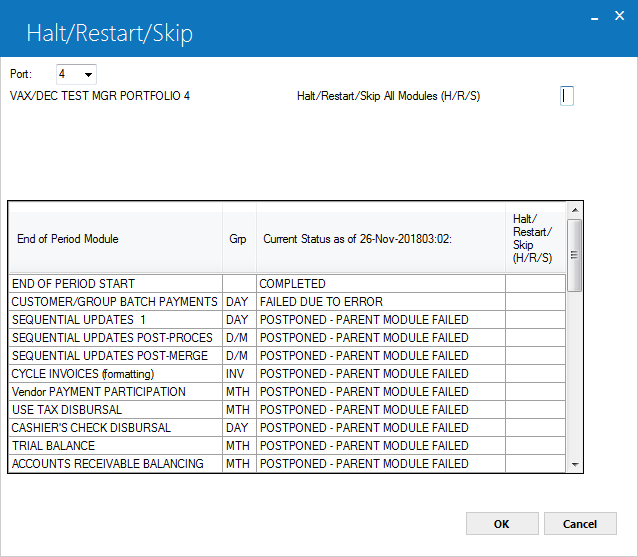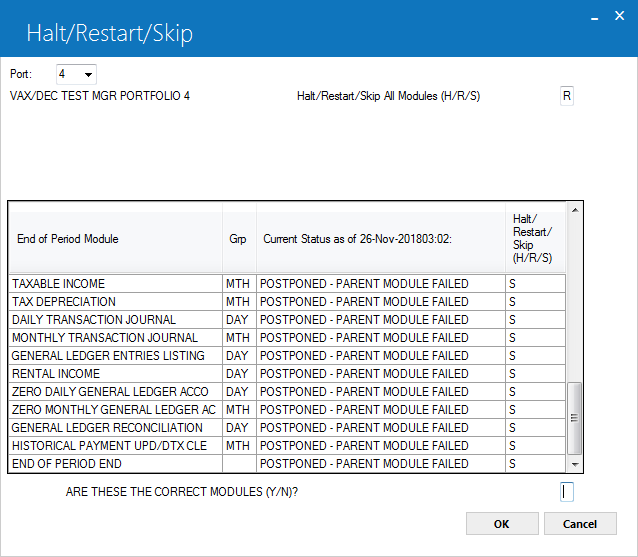 U04 End of Period
U04 End of Period
U0404 Halt/Restart/Skip
 Interactive: This is one of the interactive processess used to control and monitor End of Period. It does not have a batch counterpart or run as an EOP module.
Interactive: This is one of the interactive processess used to control and monitor End of Period. It does not have a batch counterpart or run as an EOP module.
 For more information about End of Period, refer to U04 End of Period Overview.
For more information about End of Period, refer to U04 End of Period Overview.
U0404 Halt/Restart/Skip controls the End of Period batch queue. It may be used to:
- Stop execution of an End of Period module (HALT)
- Resubmit a stopped module (RESTART)
- Skip over any incomplete module entirely (SKIP)
If not performed properly, skipping modules may cause problems, including corrupted data. Therefore, before skipping a module, obtain a clear understanding of what the module does, especially analyzing any effects on its dependent modules. For example, skipping an accrual cycle but continuing with the invoicing process causes the Invoicing update to invoice leases that have not been updated for the current billing month. In this case, both the accrual and invoicing processes should be skipped. Skipping other updates, such as the Vendor File Clean-up, does not have any adverse effect.
U0405 Restart is a subset of U0404 Halt/Restart/Skip. U0405 Restart is designed for operators who may need to restart End of Period, but who are not responsible for determining whether modules may be halted or skipped. In general, security for users should be set so that neither U0404 or U0405 is allowed, or only one is allowed, but not both.
For example, if there is a power failure while End of Period was executing, the End of Period process must be restarted after power is restored. This may be performed by any user with the security to enter U0405 Restart, and does not require the additional authority for the U0404 Halt/Restart/Skip. However, if a module of End of Period failed due to another type of error, a supervisor or someone familiar with LeasePak and its processes would be needed to restart End of Period with U0404 Halt/Restart/Skip. This person must determine whether the module should be restarted or skipped and recovered.

This screen is used to enter the portfolio of the module to be halted, restarted, or skipped.

This screen is used to specify the batch queue status changes (i.e., halting, restarting or skipping) for the End of Period modules of the portfolio selected. The name of the portfolio is displayed and should be verified as correct before making any changes.
The CURRENT STATUS displayed for each module is valid only for the CURRENT STATUS AS OF date and time displayed in MM/DD/YY or DD/MM/YY format, depending on the Date Format Preference field in U0706 Security. To view the up-to-the-minute status, cancel back to screen 1 of this update and re-enter this screen.
Field Descriptions
- HALT/RESTART/SKIP
ALL MODULES (H/R/S)
Enter H to halt all incomplete modules, R to restart all stopped modules, or S to skip all incomplete modules. Leave blank if specific modules are to be halted, restarted, or skipped.
This field may be used to enter the desired batch queue change (halt, restart, or skip) for most applicable modules. Once a selection is entered, the user may tab to individual modules and change their specific settings. For example, if all modules are to be restarted except a failed module which is to be skipped, enter R in this field. Press TAB and an R appears next to all applicable modules in the module list. Tab to the failed module and change the displayed R to S.
The status changes are:
- HALT A
halted module is stopped and taken off the batch queue. If it was currently processing,
no data file recovery is automatically performed. All dependent modules which
are waiting for the halted module to complete before beginning are also postponed
and taken off the queue. End of Period cannot be completed if halted modules exist.
The halted modules must either be restarted or skipped.
Only modules with the following statuses may be halted:
HOLDING ON QUEUE
HOLDING ON QUEUE - WAITING BACKUPS
TIMED FOR LATER EXECUTION
CURRENTLY IN PROGRESS
PENDING COMPLETION OF PARENT MODULE
PENDING INITIALIZATION
PENDING STARTUP OF QUEUE
A halt of all modules merely takes the modules off the batch queue. It does not complete the End of Period process and it does not unlock updates (i.e., interactive updating is still disallowed).
- RESTART
A restarted module recovers the data files modified by the previous (unsuccessful)
execution of the module, and starts the module from the beginning. If a module
failed due to an error, the cause of the failure must be determined and corrected
before restarting the module.
Only modules with the following statuses may be restarted:
FAILED DUE TO ERROR
HALTED BY SUPERVISOR
POSTPONED - PARENT MODULE FAILED
POSTPONED - PARENT MODULE HALTED
A restart of all modules restarts all necessary End of Period modules needed to complete End of Period. This is often an easy and safe way to restart End of Period. However, failed modules may require a correction of some type before they can successfully finish.
- SKIP A
skipped module is a module that is scheduled to execute but is not executed during
this End of Period process. If the module is currently processing, it is stopped.
The module is considered completed so that any dependent modules that are postponed
or pending completion of the skipped parent module may proceed, as if the skipped
module completed successfully. Any module which is not completed or already skipped
may be skipped.
To skip module 1 (which is currently in progress) and all its dependents (which are pending), skip module 1's dependents at the same time as module 1 is skipped, to ensure that the dependents don't start immediately after module 1 is skipped.
A skip of all modules halts all non-completed modules and unlocks the updates, thus allowing interactive updating. End of Period is stopped at whatever stage it currently is processing. Although the last end of period dates are unchanged (as if the End of Period were never submitted), it is important to note that some modules may have already been completed (i.e., some updates may have processed successfully) for the skipped End of Period. If this is not desired, restore the backups of the database made immediately prior to starting End of Period.
- HALT A
halted module is stopped and taken off the batch queue. If it was currently processing,
no data file recovery is automatically performed. All dependent modules which
are waiting for the halted module to complete before beginning are also postponed
and taken off the queue. End of Period cannot be completed if halted modules exist.
The halted modules must either be restarted or skipped.
- HALT/RESTART/SKIP (H/R/S)
Enter H to halt an incomplete module, R to restart a stopped module, or S to skip a pending module. Leave blank if no change is desired. If an entry to HALT/RESTART/SKIP ALL MODULES is made, all applicable modules are defaulted with that entry value. These defaults may be changed for specific modules by tabbing to the desired module and changing the default value. Refer to the field HALT/RESTART/SKIP ALL MODULES for more information.

This screen is used to verify that the batch queue changes entered on the previous screen are correct.
Field Descriptions
- ARE
THESE THE CORRECT MODULES (Y/N)?
Enter Y to perform the batch queue changes indicated. Enter N if the batch queue changes should not be done. If restarting modules and Y is entered, when ENTER is pressed, the message "Batch job submitted" is displayed once for each module resubmitted to the batch queue (the message appears to be flashing on the screen as it is redisplayed several times).


